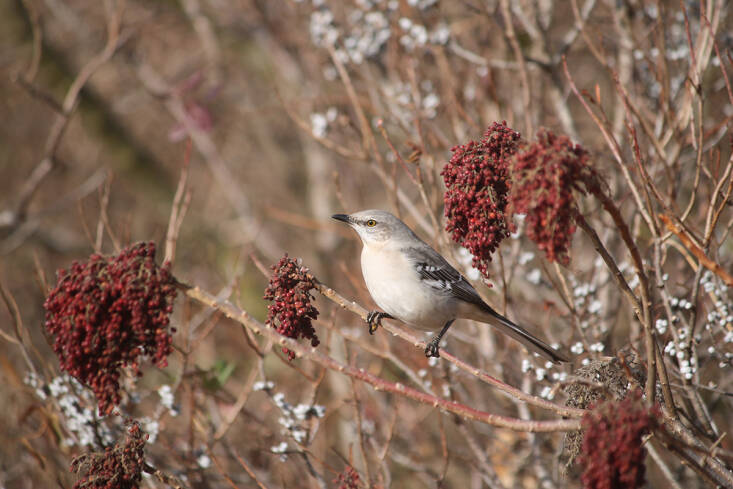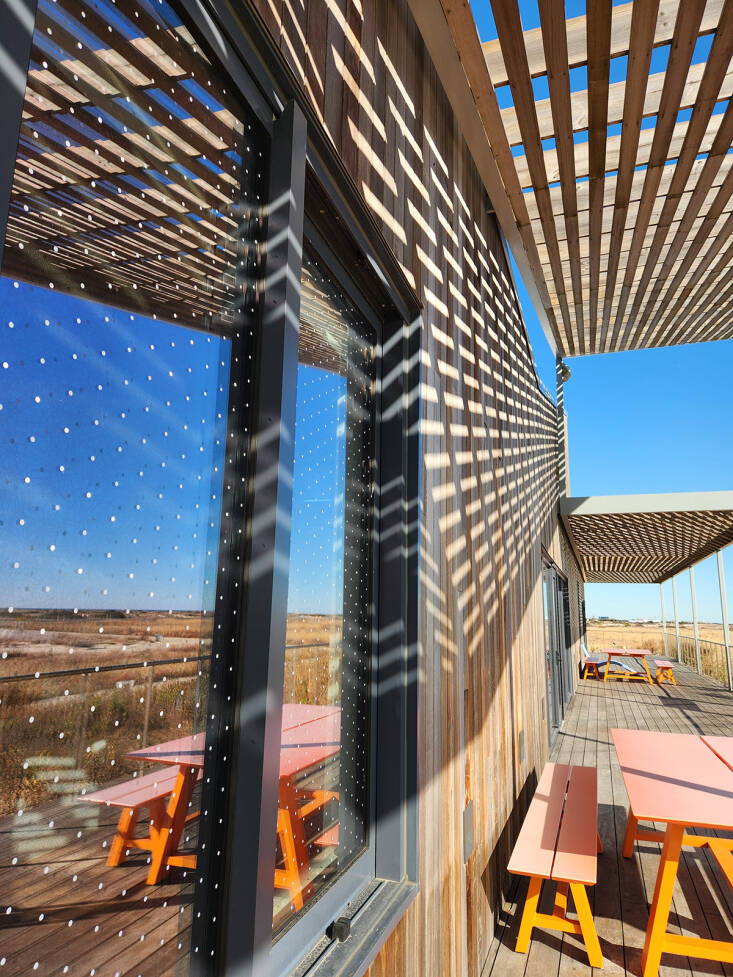When cold weather approaches, many birds head south in a great migration (of course, we’re talking Northern Hemisphere). This ancient movement in the flyways inspires equal parts awe and concern in the humans who think about such things—awe for the instinct and the survival (such small creatures, such long distances), and concern because billions of birds die every year as the result of crashing into windows, at night when cities glow in what used to be a primal darkness, and especially during the day. They deserve better. We can help birds en route south, and we can also support and attract local winter residents—the birds that do not leave town when the weather turns to frost.
Here’s how.
Photography by Marie Viljoen
1. Leave leaves and build brush piles.

Resist the urge to bag all those fallen leaves. Insect-eating birds find food—insects, slugs, snails, other invertebrates, tiny eggs—in undisturbed leaf litter. Allowing leaves to accumulate and break down also fosters better soil health, and the leafy layers act as a mulch for plants in dry spells and drought. (See Fall Gardening: 15 Ideas For What to Do With All Those Leaves.)
Instead of hauling away fallen branches, and bagging woody trimmings or invasive plants that you have just cleared out, create artful piles of stacked woody detritus. Brushpiles create shelter for birds and other small creatures and encourage biodiversity within your garden. (See Habitat Piles: Turning Garden Debris Into Shelter and Sculpture.)
2. Save the seedheads.

There is still a perception among gardeners that spent perennials look “messy” at the end of fall. Quite apart from the beauty of a backlit plume of seed-fluff, many birds will eat the seeds of plants that include golden rod, aster, Joe Pye weed, and ironweed. Later, insects like native bees can use spent hollow or pithy stalks for their winter quarters.
3. Plant autumn fruit for birds.


Birds feed on many fruits that ripen in fall and persist through winter. In New York, I have seen clouds of northern flickers (usually insect eaters and ground feeders) erupt from a flowering dogwood (Cornus florida) in fall, while every bird in town seems to visit black tupelo (Nyssa sylvatica) when its tart fruits are ripe. Other good trees and shrubs with fall and winter fruit for birds include viburnums like V. prunifolium (be sure not to plant invasive species like linden viburnum, which birds eat just as happily, and consequently spread), and bayberry (Morella pensylvanica).
For regionally appropriate native plants to help birds, check the Audubon Society’s database.
4. Keep cones and acorns around.

It’s not just fleshy fruit that will attract and help birds: Many species feed on cones like juniper (a.k.a eastern red cedar, Juniperus virginiana). Winter-resident chickadees and titmice relish the seeds inside pine cones. Flickers, blue jays, and some ducks feed on acorns, either smashing them or swallowing them whole.
5. Offer clean water.

Providing clean water is one of the most effective ways to help and attract birds. Whether it is a proper birdbath, or a re-purposed shallow container like a terracotta saucer or a vintage stone bowl, birds will soon arrive to sip and to bathe. It is very important to keep birdbaths clean. Change the water at least every three days. Although songbirds are less likely to contract bird flu, washing a birdbath regularly prevents algal build up and keeps your wild bird visitors safe from contagious diseases. (I wash our saucer-birdbath once a week with soap and water, disinfect it with a 10% Chlorox solution, rinse it very well, and fill again with fresh water.) In freezing winters you can add a birdbath de-icer to the set-up, but I just break or remove ice from the birdbath daily and then add fresh water.
Always wash your hands after handling birdbaths and bird feeders.
6. Hang suet feeders.

Blocks of suet attract an array of birds that includes woodpeckers and nuthatches. While they can be left up year-round, I prefer to hang this supplemental food from late fall through early spring. Like birdbaths, suet feeders should be cleaned regularly. I take them down after each block is eaten and scrub in soapy water, before disinfecting in a 10% Chlorox solution. Rinse, dry, and repeat. And wash your hands.
7. Provide seed for squirrel birds.

There is a limitless number of bird feeders on the market that will hold seed. The size you choose will depend on your garden space (small or large), what birds are visiting, and what design you can live with (there’s a niche out there begging for better-looking, functional feeders). Audubon offers a helpful summary of bird feeder types. For city bird lovers on high floors there are also neighbors to consider, since fallen, discarded shells don’t go over too well. Old seeds can mold, so keep the feeders replenished and clean. Wash and disinfect periodically, when a batch of seed has been eaten, before re-filling.
8. DIY a bird feeder.

A fun DIY project to help birds is to gather pine cones to stuff with peanut butter (which hardens helpfully in the cold), and sprinkle with seeds. I use human-grade, shelled sunflower seeds (less mess!) but any birdseed will work. Use narrow gauge wire to suspend the pine cone/s from branches, a trellis, or a hook mounted in the eaves.
Tip: Chill your peanut butter for 30 minutes before making the cones; the harder paste will stay in place better.

Every late fall I make a long-lasting wreath woven from either invasive mugwort stems or willow, and decorated with bird-friendly berries that attract an array of migrant and resident birds. Virginia creeper fruit, juniper (eastern red cedar), sumac, and rose hips are just some of the tasty snacks that birds enjoy.
9. Keep the cat indoors.

I grew up believing that keeping cats indoors was cruel. It’s a prejudice I shed gradually as I learned about the significant impact that outdoor cats can have on wild bird populations. A famous-slash-notorious 2013 study in Nature suggested that it was “likely” that cats cause more bird and wildlife mortalities than all other human-related threats. I find that hard to swallow. More than habitat loss? Deforestation? Pollutants and poisons? Building strikes? All of those together? The findings were based on a meta-analysis of available, observational data.
While I have doubts about their much-quoted conclusions, and the stunning numbers they suggest, I know that of course cats are hunters, mine included. So, while our first cat could lie beneath a bird feeder and blink peacefully at the wings flitting above him, our second feline is a killer in a tuxedo (he doesn’t like martinis). Unless we are with him, he stays indoors, often on the windowsill, watching live “bird TV.” In return, he receives plenty of play and stimulation and doesn’t appear to be depressed in the slightest. In short, do not put the cat out.
10. Leash the dog.

Fair’s fair. If Kitty has to stay indoors, keep Fido on a leash. Plenty of birds, especially shorebirds, rest and feed at ground (or sand) level. Come spring, that is where they nest. Some dogs might might love chasing them (with gleeful human encouragement), but this is a source of stress for birds. In woodlands, whether rural or city-based, some songbirds and other migrants (like woodcocks) rest in leaf litter. It’s polite not to have them upturned and routed by a scampering pooch. Birds face enough challenges, as it is. Respect their habitats.
11. Give them shelter.

Whether it’s a bushy evergreen like a holly, a bona fide birdhouse, or a holiday fir tree that is transferred outdoors, you can help birds by providing shelter and a windbreak in winter. On our small terrace, our Christmas fir tree moves outdoors (with some edible decorations) from mid-January. It stays fresh, still in its stand, with water, through early March, and becomes a fragrant motel for juncos, white throated sparrows, and house finches.

12. Make windows safer for birds.
Anyone who walks past or lives in a building with a lot of glass, whether it’s an urban high rise or a scenic cottage near the sea, knows about bird strikes. Reflections in glass make it hard for birds to judge perspective. They smash into glass at speed. Adding small-spaced patterns to the outside of the windows can help birds avoid deadly collisions, and more and more buildings are choosing to ameliorate these avoidable deaths.


The ideal spacing for patterns on the outside of glass is two inches, like the dots pictured above. In homes, simple bug screens can helps break up the reflections (as well as keep out bugs). A list of bird-friendly window choices is available at the NYC Bird Alliance.
See also:
- 10 Easy Pieces: Modern Bird Feeders
- Jewelweed: An Annual to Lure Hummingbirds
- The 4 Ps: What to Do in the Garden in November






Have a Question or Comment About This Post?
Join the conversation